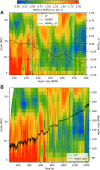Estimation of physiological exercise thresholds based on dynamical correlation properties of heart rate variability
- PMID: 38179139
- PMCID: PMC10765723
- DOI: 10.3389/fphys.2023.1299104
Estimation of physiological exercise thresholds based on dynamical correlation properties of heart rate variability
Abstract
Aerobic and anaerobic thresholds of the three-zone exercise model are often used to evaluate the exercise intensity and optimize the training load. Conventionally, these thresholds are derived from the respiratory gas exchange or blood lactate concentration measurements. Here, we introduce and validate a computational method based on the RR interval (RRI) dynamics of the heart rate (HR) measurement, which enables a simple, yet reasonably accurate estimation of both metabolic thresholds. The method utilizes a newly developed dynamical detrended fluctuation analysis (DDFA) to assess the real-time changes in the dynamical correlations of the RR intervals during exercise. The training intensity is shown to be in direct correspondence with the time- and scale-dependent changes in the DDFA scaling exponent. These changes are further used in the definition of an individual measure to estimate the aerobic and anaerobic threshold. The results for 15 volunteers who participated in a cyclo-ergometer test are compared to the benchmark lactate thresholds, as well as to the ventilatory threshods and alternative HR-based estimates based on the maximal HR and the conventional detrended fluctuation analysis (DFA). Our method provides the best overall agreement with the lactate thresholds and provides a promising, cost-effective alternative to conventional protocols, which could be easily integrated in wearable devices. However, detailed statistical analysis reveals the particular strengths and weaknessess of each method with respect to the agreement and consistency with the thresholds-thus underlining the need for further studies with more data.
Keywords: aerobic threshold; anaerobic threshold; detrended fluctuation analysis; heart rate variability; time series analysis; wearable health technology.
Copyright © 2023 Kanniainen, Pukkila, Kuisma, Molkkari, Lajunen and Räsänen.
Conflict of interest statement
KL is the founder and the CEO of company Kauppi Sports Coaching Ltd. The remaining authors declare that the research was conducted in the absence of any commercial or financial relationships that could be construed as a potential conflict of interest.
Figures




References
-
- American College of Sports Medicine (2013). ACSM’s guidelines for exercise testing and prescription. Lippincott williams & wilkins. - PubMed
-
- Binder R. K., Wonisch M., Corra U., Cohen-Solal A., Vanhees L., Saner H., et al. (2008). Methodological approach to the first and second lactate threshold in incremental cardiopulmonary exercise testing. Eur. J. Cardiovasc. Prev. rehabilitation 15, 726–734. 10.1097/HJR.0b013e328304fed4 - DOI - PubMed
LinkOut - more resources
Full Text Sources

